IN THIS ISSUE
- Bald eagles and bird flu
- Globe amaranth's allure
- SOS for right whales
 A healthy bald eagle pair in Floyd County (Jenny Burdette Photography/GNPA)
The news that avian influenza has killed bald eagles in Georgia and that DNR saw a corresponding drop in nest success along the coast has circulated worldwide. But here are the basics you need to know.
Three dead bald eagles found in March in Chatham, Glynn and Liberty counties were confirmed this month with highly pathogenic avian influenza (HPAI), specifically the H5N1 2.3.4.4b Eurasian strain.
Fewer than half the eagle nests DNR monitors in Georgia’s six coastal counties fledged young this year. That’s about 30 percent less than the average success rate the last seven years. Statewide findings indicate that only the coast suffered such a sharp decline, survey leader Dr. Bob Sargent said.
To date, the nesting impact has been documented only in Georgia. But of the 30-plus states where HPAI has been found in wild birds this year, bald eagles have been confirmed with the viral disease in 16.
Avian influenza infects wild and domestic birds and other animals worldwide. HPAI strains are highly infectious, untreatable and potentially lethal to animals. The risk of transmission to humans is low.
Sargent said the bald eagle population in Georgia is growing and HPAI isn’t expected to significantly slow the species’ rebound. The coast was likely harder hit because HPAI is typically carried by waterfowl and shorebirds, and with ducks gathering in large rafts on coastal waters in winter, eagles could have received more exposure to the virus as they preyed or scavenged on dead or sick waterbirds.
Sargent also noted that HPAI may not be entirely to blame for the decline in nest success on the coast. Eagle nests fail for a variety of reasons, including weather.
WHAT YOU CAN DO
ABOUT BIRD FEEDERS
Judging the risk of an avian flu outbreak in songbirds low, the Cornell Lab of Ornithology recommends keeping feeders in use and clean. Ditto for birdbaths. (The exceptions are when a state advises taking feeders down or a person keeps poultry.)
FURTHER READING
"Record avian flu outbreak threatening North America's birds; is the virus here to stay?" (Science)
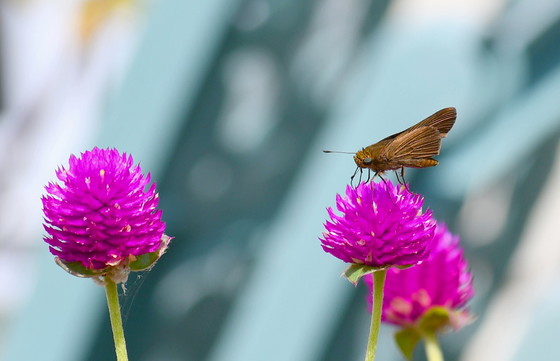 Ocola skipper on a globe amaranth bloom (Terry W. Johnson)
By TERRY W. JOHNSON
My wife and I are constantly seeking new plants to add to our wildlife gardens. Our primary objective is to use native plants that are pleasing to the eye and provide a wide range of wildlife with food throughout the year.
However, we also use some noninvasive ornamentals. When choosing these, we are particularly fond of plants with historical associations.
One we first tried a few years ago is globe amaranth (Gomphrena globosa). The plant blooms from late spring into October, generates nectar for a variety of butterflies, bees and other pollinators, and produces seeds relished by some of our favorite backyard birds.
If that’s not enough, the plant will not spread beyond your yard and, while native to Central America, it has a history in North America that dates to the colonial era and some of our nation’s founders. …
Read Terry’s Out My Backdoor column for tips on growing globe amaranth and insights into the wildlife this plant attracts.
Terry W. Johnson is a retired DNR program manager and executive director of TERN, the Wildlife Conservation Section’s friends group. Check out past columns, his Backyard Wildlife Connection blog and his book “A Journey of Discovery: Monroe County Outdoors.” Permission is required to reprint his columns.
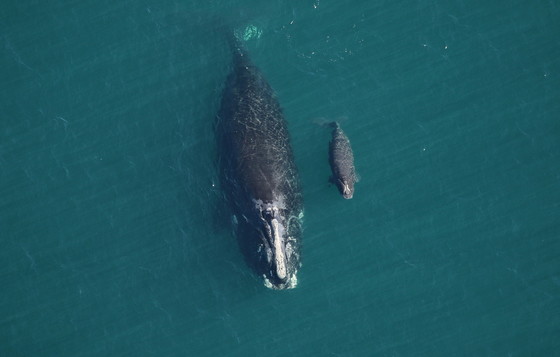 Right whale no. 3157 and her calf off Cumberland Island in February (FWC/NOAA permit 0556-01)
With calving season over for North Atlantic right whales, the wrap-up is sobering.
- Fifteen calves were spotted this winter off the Southeast. That puts the average seen each year since 2010 at 12 calves, far shy of the 50 or more a year NOAA says is needed for the species to recover.
- There are fewer than 350 North Atlantic right whales left. NOAA’s estimate in 2020, the latest available, was 336 – plus or minus 14 whales. Ten years before, the estimate was 476. Scientists believe there are fewer than 70 female whales remaining that can bear young.
- Low birth rates and unprecedented high mortality rates (up to 150 whales may have died since 2014, per NOAA) mean the species will likely continue to decline, writes DNR senior wildlife biologist Clay George. He calls the combination “a continuing double-whammy.”
- Almost all right whale deaths are caused by humans, via fishing rope entanglements and vessel strikes. Climate-change impacts on the plankton that whales eat also may be limiting calf production.
- Of this year’s 15 moms, one is entangled in commercial fishing gear that might ultimately kill her. Another gave birth to an emaciated calf that likely died. The entangled whale, no. 3560, named Snow Cone, has rope embedded in her jaw (video). She and her calf were recently seen off Cape Cod, having migrated back to the species' summer feeding grounds. However, an observer said Snow Cone was “noticeably skinnier.”
- One last number, and it's welcomed: zero. That’s the count of whales hurt or killed by boaters in the Southeast this winter. After boat strikes killed two calves and injured a mother in 2020 and 2021, DNR reached out to boaters, urging them to slow down and keep watch. Hopefully it helped.
As for the main takeaway from this calving season, George, who leads DNR’s conservation work with right whales, is to the point:
"If we don’t address human impacts on right whales, especially fishing rope entanglement in New England and Canada, the species could be functionally extinct in a few decades.”
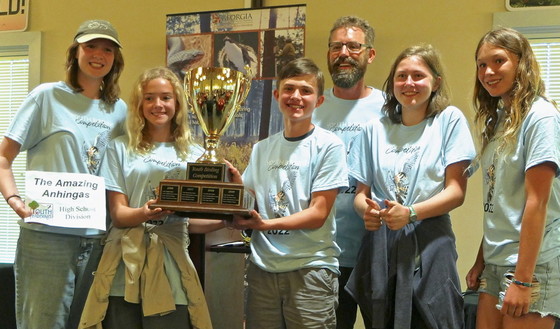 High school and overall winner Amazing Anhingas with competition coordinator Tim Keyes (Linda May/DNR)
What do you get when you blend in-person and virtual participation with Georgia’s first spring Youth Birding Competition since 2019? A crowd.
The popular event’s return to the peak of spring migration spurred about 120 children and teens to scour the state for birds over a nine-day period that ended with an awards ceremony Saturday night.
Canceled in 2020 and held as virtual-only last fall, the 16th annual competition was held in April and in person again this year. But DNR kept the virtual option to address COVID concerns and avoid requiring teams to make a long drive to Charlie Elliott Wildlife Center in Mansfield – traditional site of the awards ceremony – to submit their checklists.
The hybrid approach led to 38 teams registering and a large, excited group showing at the Charlie Elliott banquet hall for the ceremony. Members from about 10 teams joined the presentations online.
Competition coordinator Tim Keyes said this was “obviously an experiment year and we learned some things we can do better. But hopefully it gave a broader range of kids an opportunity to participate.”
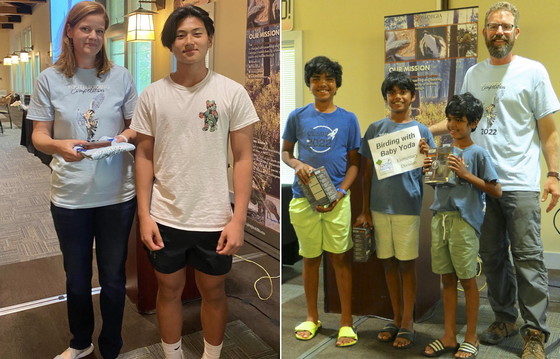 Top artist Arvin Guo with DNR's Linda May; (right) elementary champs Birding with Baby Yoda (SKA Academy; DNR)
The Amazing Anhingas, a High School Division team, found 128 bird species to claim the title as champs. Four other teams – including the top elementary and middle school teams, Birding with Baby Yoda and Pi-billed Grebes, respectively – listed 90 or more.
The Elementary Division’s Lil Birdie Rascals raised $735 for conservation, the most of any team. Maegan Donnell and Grace Campbell shared the Mentor Award for their work with the Decatur school teams McLendon Chickadees and Bluehawks.
The event’s T-shirt art contest fielded 132 entries. Teams received shirts sporting an American kestrel drawn by Suwannee ninth-grader Arvin Guo of SKA Academy of Art and Design in Duluth.
Complete results. Photos: winning art. Video: art entries (by volunteer Chris May).
SPEAKING OF MIGRATION ...
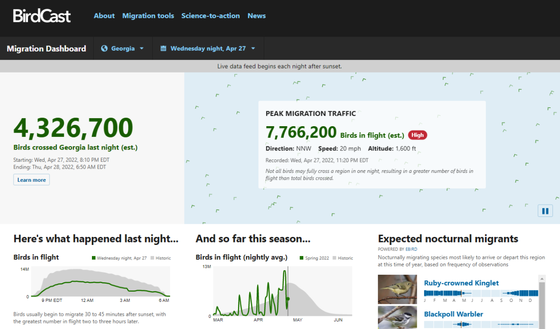 Spring and fall migration are obviously key times to see birds. But BirdCast, which turns radar and other data into forecasts and maps, pictures the mind-boggling scope of migration on a nightly basis with estimated counts by state and county. For example, on Tuesday night some 1.2 million birds crossed Georgia and so far this spring more than 179 million have flown through the state.
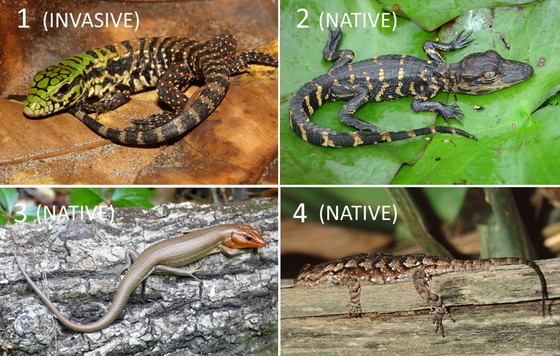 Georgians are asked to report tegus in the wild, especially in Toombs and Tattnall counties, where the big invasive reptiles have established a population. However, eastern fence lizards and other native species have been misidentified as juvenile tegus. Can you tell who's who above? Answers at georgiawildlife.com/tegus.
Recovering America’s Wildlife Act cleared another hurdle with bipartisan approval in the U.S. Senate Committee on Environment and Public Works, steering the legislation toward a full Senate vote. In January, the House Natural Resources Committee advanced its version of the bill that would provide $1.4 billion for state and tribal wildlife agencies to conserve about 12,000 species in need. Proposed Georgia projects.
Prescribed fire is helping restore federally endangered hairy rattleweed on Sansavilla Wildlife Management Area. The Wire Road Tract, part of the Wayne County WMA, provides a protected home for the long-lived legume known from only two Georgia counties and dependent on regular fires to maintain its habitat.
 Peep camera glimpse of red-cockaded woodpecker eggs in a nest cavity (Joe Burnam/DNR)
DNR biologists monitoring red-cockaded woodpeckers in southwest Georgia have already marked 15 nests, with more to come. Nestlings of the rare woodpeckers will be banded at 7-10 days old to help track individual birds and the overall population.
Snake encounters leave many people wondering two things: What species is this and what should I do? In this news release, DNR senior wildlife biologist Daniel Sollenberger gives some go-to guidance. Learn more.
Georgia’s first survey of horseshoe crab spawning sites is being done by DNR and partners during three high lunar tides this spring. The eggs of horseshoe crabs, ancient creatures more closely related to scorpions and spiders, are vital for migrating shorebirds like red knots, which gorge on the eggs (birds can almost double their weight in weeks) before flying the final leg of their journey to the Arctic.
 Learning about eastern indigo snakes at the Keeping Georgia Wild festival (DNR)
Quick hits:
- Make plans to get wild at the Keeping Georgia Wild festival, a free, family-centered event focused on wildlife and set for May 21 at Charlie Elliott Wildlife Center near Mansfield.
- Coastal Georgia earned an A- on the latest Ecosystem Report Card, a review commissioned by DNR’s Coastal Resources Division and measuring metrics such as red drum abundance and sea turtle nesting.
- Feeding bears, leaving garbage and other potential food sources unsecured, and approaching bears can all put you and them at risk, says BearWise.org.
- The Georgia Prescribed Fire Council’s annual north Georgia meeting will be in-person June 9 at Chattahoochee Technical College in Jasper, with talks varying from private land fire initiatives to burning for white-tailed deer.
- While low-head dams may appear picturesque and peaceful, the hydraulics created by these stream-wide structures can pose significant risks to anglers, kayakers and swimmers, according to this article spurred by Low-head Dam Public Safety Awareness Month.
- City Nature Challenges – iNaturalist-powered blitzes to report flora and fauna in a set area via iNaturalist – are planned in Atlanta and the Savannah area April 29-May 2.
- Also coming up: a May 14 Pollinator Party at Bear Creek Nature Center in Chattahoochee Hills and the Environmental Education Alliance of Georgia's Outdoor Learning Symposium June 24 at Life University in Marietta.
Names in the news: DNR wildlife biologist Todd Schneider teamed with Elizabeth Hunter of Virginia Tech and Georgia Southern’s Abigail Dwire to study population dynamics of Henslow’s sparrows wintering in powerline rights-of-way in southeast Georgia. The findings, published in Journal of Field Ornithology, come from an 11-year mark-recapture effort detailing how the sparrows, one of many grassland birds in decline, use rights-of-way. Delton Hilliard, a Rhine, Ga., resident who provided pro-snake educational programs at former rattlesnake roundups, including in Fitzgerald, died at age 82 this month. DNR marked the passing in March of Brunswick's John Monroe Pafford Sr., 74, a 34-year marine biologist who in his final years at DNR served as recreational fisheries supervisor.
WHAT YOU MISSED ...
In the previous Georgia Wild:
- Don't underestimate owls
- Cabbage white: devil or angel?
- Atlanta peregrines' new penthouse
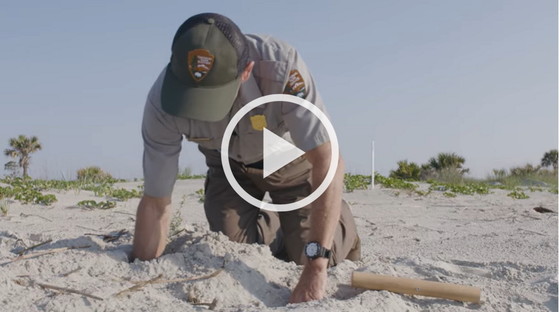 "Feral Swine in America: Episode 5/Georgia," APHIS, includes a segment on Cumberland Island and sea turtle nesting (series playlist)
(audio) "Black birder wants to change perceptions of who belongs in nature," GPB
"Alligator snapping turtle lures," DNR
Burner Bob promotes Savannah River Fire Festival, WTOC-TV (Ch. 11, Savannah)
(audio) "How to give a whale a pregnancy test? Check its poop," NPR
"Alligators bellowing as mating season begins," WTVJ-TV (NBC 6, Miramar, Fla.) (video by Bobby Wummer)
"Gopher tortoise hatchling," DNR
"Bird flu kills bald eagles in Chatham, Liberty, Glynn," WTOC-TV (Ch. 11, Savannah) and others. Related: WAGA-TV (Ch. 5, Atlanta), USA Today, The New York Times (paywall), UGA Today.
"Lackluster calving season leaves right whales' future uncertain," The Atlanta Journal-Constitution. Related: GPB, The Washington Post, Miami Herald.
"Invasive lizard that can 'eat almost anything' spotted again in Georgia," Axios. Also: The (Vidalia) Advance, Georgia Virtue, CBS News, WSB-TV (Ch. 2, Atlanta) and others.
"Florida man traps over 100 invasive tegu lizards," USA Today
"Combo Youth Birding Competition draws a crowd," EIN
"Georgia Forestry requests BOLO for invasive cogongrass," AllonGeorgia
"Thomas U, organizations will use grants for Lost Creek Forest," WALB-TV (Ch. 10, Albany)
"Targeted strategy may keep wildlife safer from cats," The Current
"What to do when you see a snake," Yahoo!News (via The Albany Herald) and others
"Coastal boaters urged to watch for sea turtles, manatees," WSB-TV (Ch. 2, Atlanta). Also: Times-Union (Jacksonville, Fla.) and others via AP.
"Swamp mystery: Okefenokee gators missing many teeth," GPB
"Improving Georgia land conservation through algorithms," UGA Today
Top
CREDIT
Georgia Wild masthead: American kestrel drawing by Arvin Guo, high school and grand-prize winner in the 2022 Youth Birding Competition T-shirt Art Contest (SKA Academy of Art and Design)
|